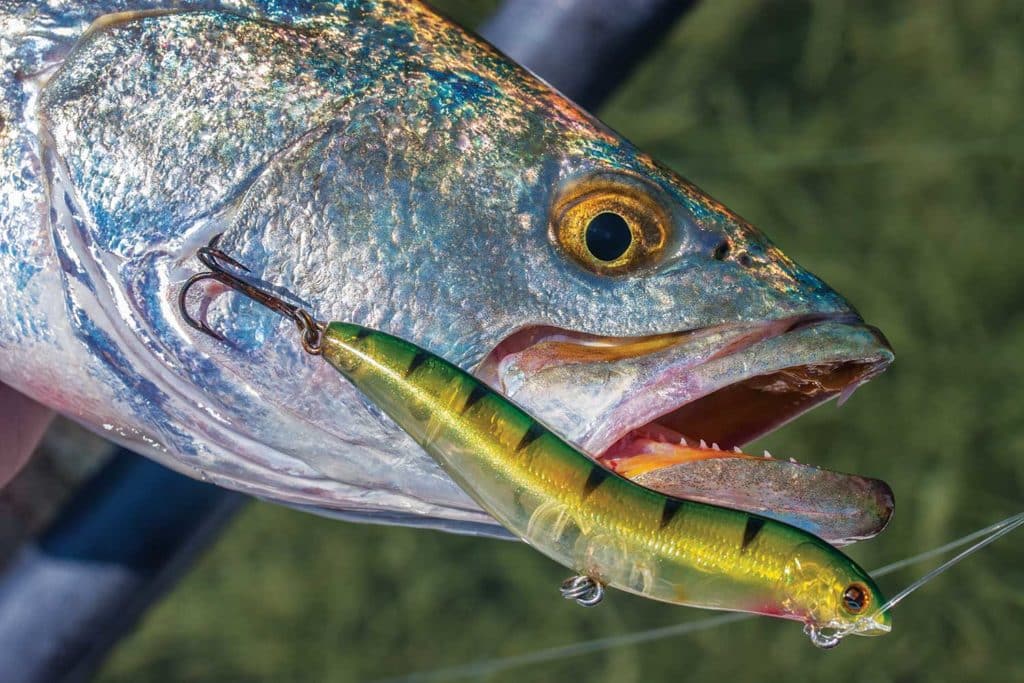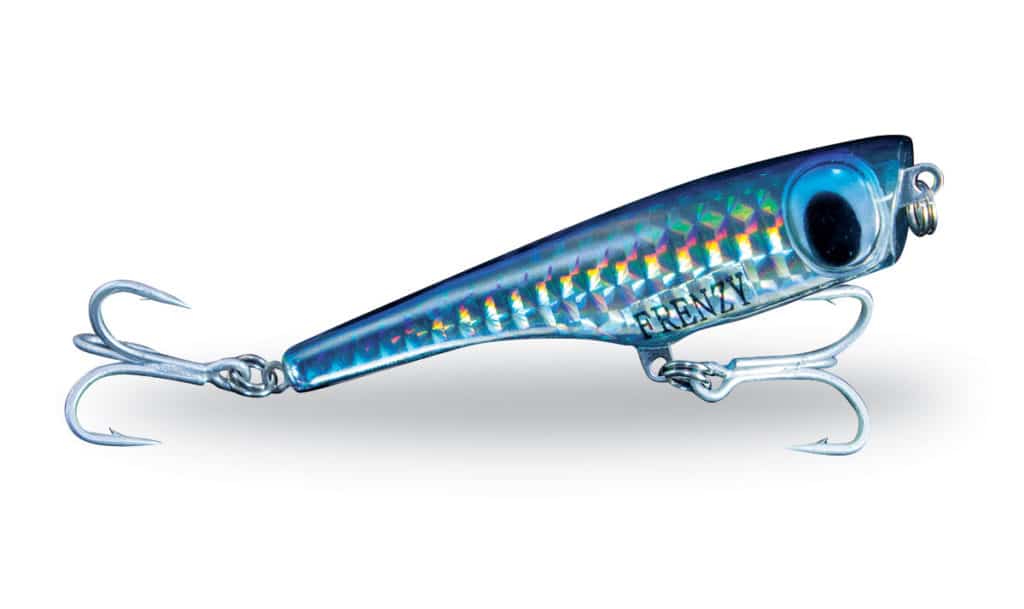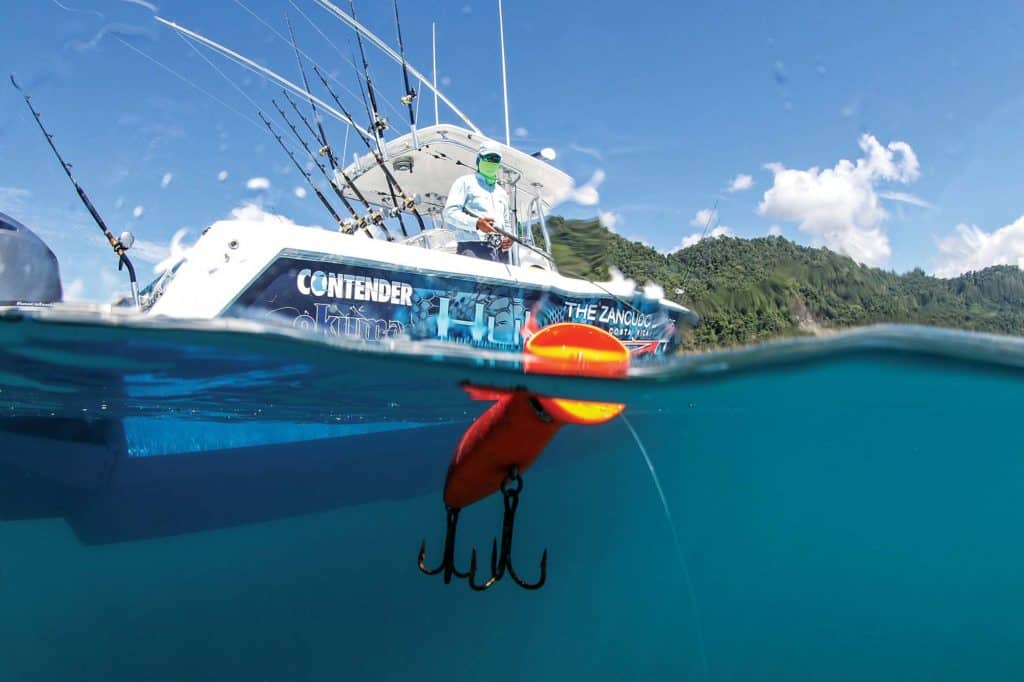
Whether they bloop, swish, chug, rattle or plop, all topwater plugs make noise as they move through the water. And all anglers agree that the explosive smash of a game fish on topwater is an adrenaline-charged strike that’s tough to beat.
But when does the pop of a popper or the chug of a chugger draw in game fish, and when does it turn them off? When does walking the dog top the pop? How does an angler know which to choose, when and why? To find out, I talked to a number of pros from a wide geographical range of topwater fisheries. Shockingly, they all agreed on which choice to make, and when. Almost.

Plugging in Panama City
Capt. “J.P.” James Pic, of JP2Fish charters, has been casting the waters in and around Panama City, Florida, for more than 50 years. And on countless casts, he has had topwater plugs tied to the end of his line. When asked about pops and chugs versus the classic walk-the-dog style of topwater fishing, he has a straightforward and simple answer.
“Most of the time, I prefer to walk the dog,” he says. “Usually I like a slow walk with a bone-colored Zara Spook or similar lure. I’m usually targeting trout and redfish, and a loud chugger is probably my last choice for these species.”
However, Pic explains that he uses a chugger for trout when the sun is high and fish are still interested in topwater but don’t want to come to the surface — though he uses it in a different way. He removes the rear hook and replaces it with a few feet of 20-pound fluorocarbon. Then he ties on a D.O.A. shrimp at the end of the line. “Nineteen times out of 20, a trout will hit the shrimp before the plug,” he explains. “I don’t think the popper resembles anything in nature, but the noise does get the fish’s attention.”

When Pic finds bluefish or big Spanish mackerel in open water, he wants more commotion. “These fish like a lot of noise on top of the water, and sometimes the popper will get an absolutely ferocious hit.”
He also notes that an angler’s topwater options aren’t just limited to these two types of lures. “Sometimes when you aren’t catching fish and you need to experiment, ripping a prop-bait across the surface is a good move,” he says. “I find that the Heddon Torpedo can be effective when other lures aren’t working as well for no apparent reason.”
Texas Topwater
Many miles west along the Gulf coast, Capt. Allen Sifford of Fish On Guide Service is pushing his third decade of full-time inshore guiding on the waters of Corpus Christi, Texas. Sifford starts off with amazingly similar advice.
“Walking the dog normally works best for speckled trout and redfish,” he says. “The bigger question is really how you work the bait. Speed is the key. Usually in warmer water, the fish want it faster, and in cooler water, they want it slower. But some days they just want it moving at a different speed entirely.”
As I dug deeper into the question, however, exceptions popped up. “When I’m fishing for tarpon, I might reach for a chugger,” he says. “Especially when schooled fish are rolling. When they’re competing to eat, that’s the time those types of lures work best.”
Sifford also notes that at times you do have to be careful. “In shallow water, I do think a loud chugger or popper can spook some fish, some of the time,” he says. “And sometimes, a small pop and then a pause is better than steady motion. But generally speaking, I have to say again, I usually walk the dog when fishing topwater for the specks and reds, so it’s not common for me to be using them in quiet, shallow waters.”

Chesapeake Chugger
Along the central U.S. East Coast, Capt. “Walleye” Pete Dahlberg of Four Seasons Guide Service fishes a mix of shallow water, deep structure and open water during more than 250 days each year. He too finds walk-the-dog presentations best in the shallows, when speckled trout and redfish are the target.
“When I fish in gin-clear water over weed beds near the islands (of the Tangier Sound, where speckled trout and redfish are common targets), I like the subtle look,” he explains. “Particularly when it’s flat calm, that’s usually the way to go.”
When it comes to a wider variety of species, particularly more-aggressive ones feeding in open water, he agrees that more-violent tactics take over. “When rockfish are aggressively feeding, when they’re competing, that’s when I like the popper,” he says. “I do think it might pull them in from a distance, and poppers seem to get them more excited at times. When there’s an entire school of fish feeding on the surface, often a popper will catch the biggest fish in the mix.”
Dahlberg also points to size as an important consideration. “I like smaller lures for the specks, for sure, maybe 3- or 4-inchers, but I like 5- or 6-inch plugs for the stripers.”
Dahlberg says Stillwater Smack-Its and Chug Bugs are a couple of his favorites. He does keep an open mind, though, because in some areas of the Chesapeake, he might encounter multiple species, along with other aggressive fish such as blues and Spanish mackerel. “A lot of the time, I’ll start with two of my guys casting walk-the-dogs and two of them casting poppers. You really don’t know which the fish will prefer on any one day until you try different things.”
Anglers should note the potential danger of using the wrong bait at the wrong time. “You have to be careful,” he says. “I do think poppers can spook fish when you misuse them. Some people move the rod tip too long a distance, and make the lure thrash or jump out of the water, which definitely doesn’t look right to the fish.”

Consensus of the Captains
It’s truly rare to speak with three inshore captains from such different locations and hear them all agree. So I think it’s pretty safe to take their commonalities to the bank:
When fishing for specks and reds in calm, shallow water, walking the dog is probably your best strategy.
It’s possible, particularly in very calm or shallow waters, to spook fish with chuggers.
When fishing for aggressive or competitive fish, especially schooled in open water, poppers and chuggers win.
The concept of matching a plug’s volume level with a fish’s aggression level generally guides offshore tactics as well. For bluewater anglers, lures that make a big surface disturbance are also the most effective.
Read Next: A Guide to the Most Popular Lures
“Offshore fish are very competitive,” notes Tommy Theus of Frenzy Big Game Tackle, maker of the Angry Popper, which is specifically designed for offshore topwater action. “Plus the water usually isn’t flat calm. You might be trying to call fish from deeper water or farther away, and on top of all that, the gear you’re using is heavier and might not be ideal for walking the dog in the first place. So making as much noise as possible with a big heavy popper is usually the best choice for offshore fish.”
The one other thing all of these experts agree on? Whether that lure is making a bloop, swish, chug, rattle or plop, few things in fishing or life beat the thrill and excitement of a topwater explosion.








